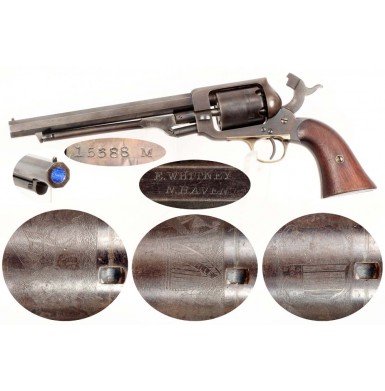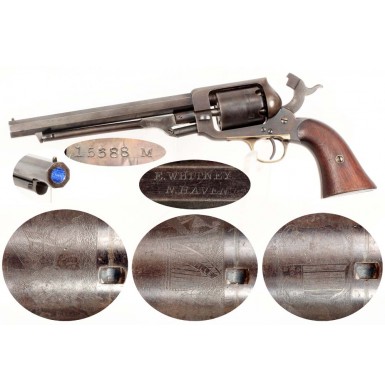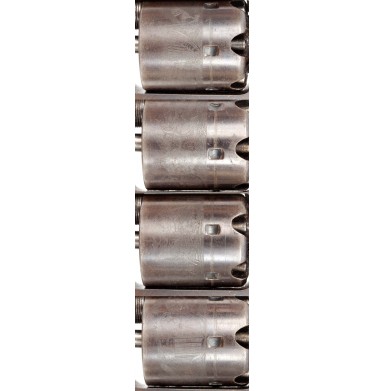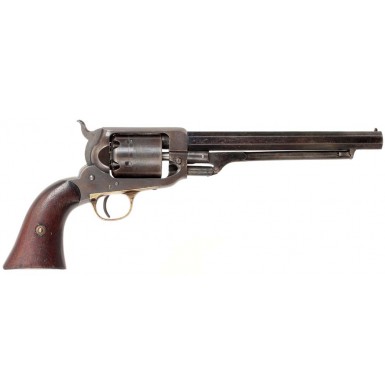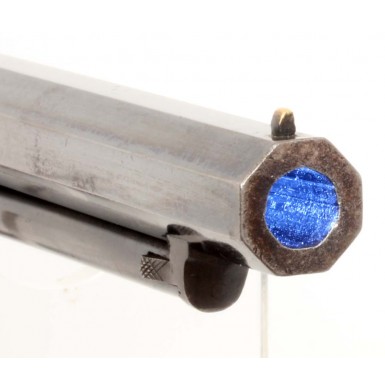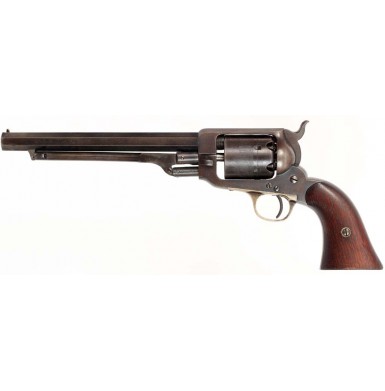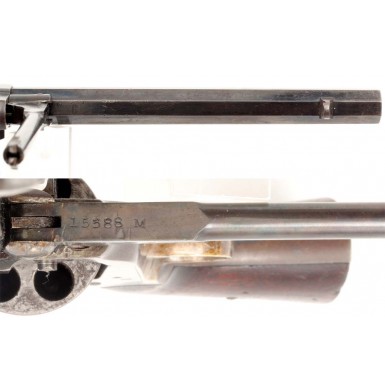This is a VERY FINE condition example of a Whitney Navy percussion revolver from the era of the American Civil War. The Whitney Navy was a 6-shot, .36 caliber, single action percussion revolver that was manufactured from the late 1850s through the early 1860s. The revolver went into production after Colt’s patent on his revolver mechanism expired in 1857. The first 1,500 or so (aka “1st Model Whitney Navy revolvers) were manufactured without a loading lever and were of lighter construction than the later 2nd Model revolvers. Between the Whitney desire to improve upon the guns, and the habit of making design changes when parts on hand ran out, both the 1st and 2nd Models were manufactured in a number of different “types’ with a clear pattern of evolution that took place throughout their production. Some 33,000 Whitney Navy revolvers were produced during the production run, with many seeing US government use. The US Army acquired 10,587 of the revolvers between 1861 and 1864 and the US Navy purchased an additional 6,226 between 1863 and 1865. The state of New Jersey purchased 920 Whitney Navy revolvers in 1863, but 792 of those guns were subsequently resold to the US Army in 1863 and 1864. Those guns are included in the US Army purchases listed above. A number of Whitney Navy revolvers also appear to have been acquired by the South and saw service during the American Civil War. Some were purchased prior to the outbreak of hostilities, and these guns tend to be early production 2nd Model revolvers produced prior to the spring of 1861. A good example is Whitney Navy #3110, which was owned by Confederate cavalry general J.E.B. Stuart, and is now in the collection of the Virginia Historical Society. However, Confederate forces acquired many more Whitney Navy revolvers after the conflict started. These later production guns were no doubt obtained through a combination of capturing weapons and purchasing the guns surreptitiously from secondary retailers rather than Whitney. At least two-dozen Whitney Navy revolvers are known to have been repaired for use by the 4th Virginia “Black Horse” Cavalry, and a handful of identified Whitney Navy revolvers with Confederate provenance exist was well. It is not surprising that the revolver found favor on both sides of the Mason-Dixon line, as the robust design with a reinforcing top strap, a solid frame with a screwed in barrel and the simple turn of a wing nut to release the loading lever and cylinder arbor were all significant improvements over the open top frame and wedge-retained barrel of the Colt design. The popularity of the revolvers in the south is further indicated by the fact that the design was copied by Confederate gunmakers like Spiller & Burr and T.W. Cofer, both of whom produced Whitney-like revolvers for the south.
This Whitney Navy Revolver is serial number 15388 M, and is an early production 2nd Model 4th Type. This variant of the Whitney Navy is encountered in the approximate serial number range of 15,000 to 25,000. The primary identifying feature of the 2nd Model 4th Type Navy revolvers were the change in the cylinder roll scene from an eagle, shield and lion to an eagle, shield, lion and naval engagement with “Whitneyville” added in a banner within the shield. The 4th type revolvers retained the Colt-style, wedge shaped loading lever latch that had been adopted with the 3rd type revolvers, replacing the earlier ball detent catch. The pistol bears the matching serial number 15388 on the loading lever, on the bottom of the barrel (concealed by the loading lever), on the rear face of the cylinder and stamped inside both of the grip panels. The serial number places only 31 numbers away from a list of 2nd Model Whitney Navy revolvers that were repaired by a Warrenton, VA gunsmith for the 4th Virginia Cavalry, aka “Black Horse Cavalry”. The regiment no doubt had a much larger number of Whitney Navy revolvers in service, but the list only contains those that were in need of mechanical work. The top of the 7 ““ octagon barrel is crisply and clearly stamped in two lines: E. WHITNEY / N. HAVEN. This Whitney Navy Revolver is in about VERY FINE condition. The gun retains a large amount of original finish for a Whitney Navy, probably about 30%-40% overall. The original bright blue is most plentiful on the barrel, especially on the bottom, where the loading lever has protected it. The barrel retains about 60% of its original blued finish; with most of the loss being due to flaking and honest wear from holster carry. The blue remains in large streaks and flecks along the barrel, with the balance of the barrel having developed a smooth plum brown patina that makes the barrel look like it retains about 80% finish when viewed in most lighting. The frame retains about 20%+ of its original blue, mostly on the lower portions, with the balance worn off or faded from carry and use. Like the barrel, a smooth plum brown patina remains where the blue has worn away. The cylinder retains a similar amount of original blue, at least 20% and maybe as much as 30%. It has also dulled and faded from carry and holster wear, with the brightest patches of blue being in the protected nooks and crannies of the cylinder bolt stop slots and in the recesses of the roll engraved cylinder scene. Typically Whitney Navy revolvers retain no cylinder scene, due the fact that scene was often lightly rolled and the hard service that they tended to see. Even Whitney Navy revolvers that did not see hard use typically have weak or non-existent scenes due to how lightly they were applied. The cylinder scene on this revolver is truly outstanding and might be the best condition Whitney Navy cylinder scene that I have encountered. The scene is at least 95% in tact and remains extremely crisp and sharp; suggesting the holster this revolver was carried in was very soft and pliable (Confederate pig skin?). The close up photos of the cylinder scene below do not due the crispness and clarity of the scene justice. The metal of the gun is almost entirely smooth throughout, with only some very lightly scattered patches of minor pinpricking present, mostly on the front edge of the frame, in front of the cylinder chambers, in the cone (nipple) recesses and at the muzzle. The loading lever retains about 40%+ of its original case coloring, which has dulled to a smoky blue-gray patina with scattered mottling and traces of blue and purple coloration. The most obvious patch of case coloring is on the top of the loading lever where the serial number is stamped. The gun appears to be 100% complete and correct in every way. The revolver remains very crisp and retains strong markings throughout. The action of the revolver is mechanically excellent and the gun times, indexes and locks-up exactly as it should. All of the original cones (nipples) are present, and are in very good, crisp and usable condition. The original brass-post front sight is in place at the end of the barrel and is in fine condition as well. The bore is in about FINE condition. It is mostly bright, mixed with some flecked patches of darker oxidized brown patina. The bore retains very good, very strong 7-groove rifling. The bore does show some lightly scattered pitting along its entire length, with a couple of small patches of more moderate pitting noted as well. The original arbor pin retention wing nut is in place and still operates exactly as it should, and even the retaining screw for the wing nut appears to be original to the revolver. The hammer retains some weak traces of its original case coloring, which has faded to a dark a smoky blue-gray color for the most part. The trigger retains about 30% original blue, which has faded to a deep, smoky plum patina. The smaller brass trigger guard (correct for this model) has a medium golden patina and retains some strong traces of its original sliver plating. The pistol remains extremely crisp throughout with sharp edges on the barrel, and crisp screw heads showing minimal slot wear, with only one frame screw showing moderate wear. Most of the screws even retain some of their fire blued finish, with the grip screw retaining about 50%+ fading blue, and the rest of the screws retaining anywhere from traces to about 50% of their original blue, which has dulled with age. The two-piece oil finished walnut grips are in about FINE condition. They are complete and solid with no breaks, cracks or repairs. There is one chip missing out of the rear edge of the left grip panel, a small piece about ““ long. This is old, period of use damage and it is really the only issued worth noting in regards to the grips. The grips do show the some of the normally expected bumps and dings from service and use, but even these are minimal. Amazingly they have essentially survived without the expected dinging and impact marks on their bottoms, where Civil War era pistols were inevitably used as hammers during their service life!
Overall this is an extremely crisp and complete example of a Whitney Navy 2nd Model 4th Type Revolver. This is a 100% complete and correct example of a Whitney Navy that is in tremendously better condition than they are typically encountered. The gun is very attractive, and in person (under normal lighting) appears to have even more finish than the harsh photographic lights tend to indicate in the photos below. The revolver clearly saw real world carry and use but was extremely well cared for. The gun is in a great serial number range and almost assuredly saw Civil War field service, likely with the renowned 4th Virginia Cavalry. This very fine Whitney Navy will be a fantastic addition to your collection of Civil War secondary martial revolvers and is a gun you will be very proud to display.
SOLD
